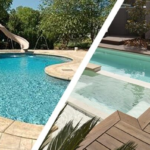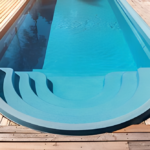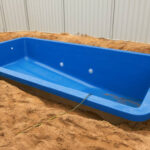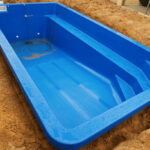Fiberglass pools have become increasingly popular in recent years due to their durability, low maintenance, and customizable design options. However, one question that often arises when considering a fiberglass pool is whether or not they are slippery.
The answer to this question “Are Fiberglass Pools Slippery?” is not a simple yes or no, as there are several factors that can affect the slipperiness of a fiberglass pool.
One factor that can affect the slipperiness of a fiberglass pool is the type of gelcoat used. Gelcoat is a resin-based material that is applied to the surface of the pool to give it a smooth finish.
Some gelcoats are formulated to be more slip-resistant than others, so it is important to consider the type of gelcoat used when choosing a fiberglass pool.
Additionally, the texture of the pool surface can also play a role in slipperiness. Some fiberglass pools have a textured surface that provides more traction, while others have a smooth surface that can be more slippery.
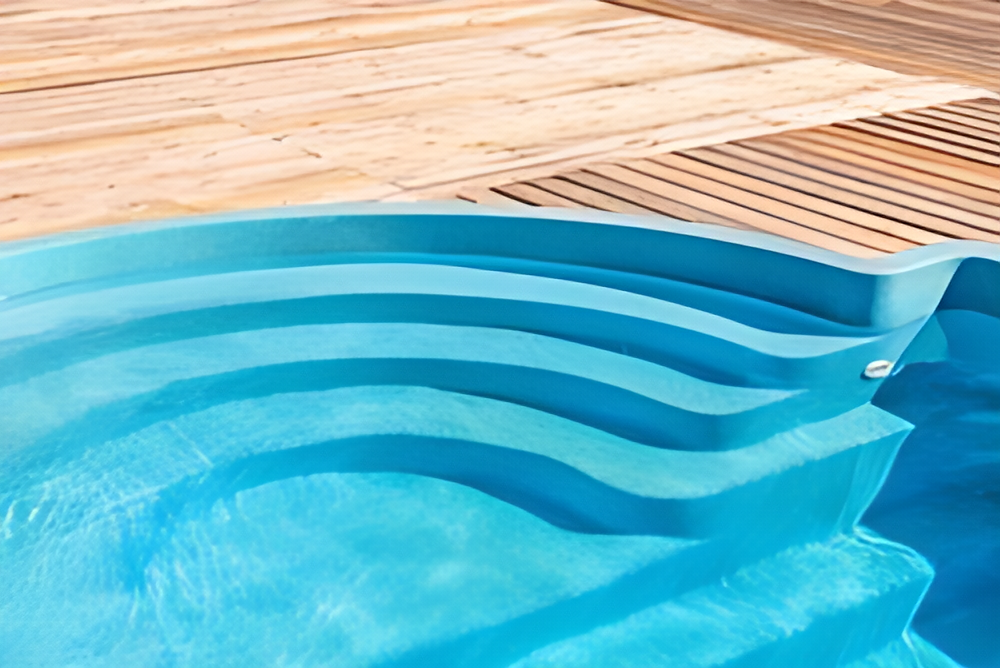
Understanding Fiberglass Pools
Fiberglass pools are a popular choice for homeowners due to their durability, low maintenance, and quick installation time. They are made of a composite material consisting of fiberglass strands and resin, which is molded into the desired shape and size.
One of the common concerns among potential fiberglass pool owners is whether or not they are slippery. While all pools can be slippery when wet, fiberglass pools are no more slippery than other pool types. The surface of a fiberglass pool can be textured to provide additional grip and prevent slipping.
Fiberglass pools also have a non-porous surface, which makes them resistant to algae growth and other types of stains. This means less time spent cleaning and maintaining the pool, and more time spent enjoying it.
In terms of customization, fiberglass pools offer a wide range of options in terms of size, shape, and color. They can also be equipped with various features such as waterfalls, lighting, and heating.
Overall, fiberglass pools are a great option for homeowners looking for a low maintenance and durable pool option. With proper care and maintenance, they can provide years of enjoyment for the whole family.
Are Fiberglass Pools Slippery?
Fiberglass pools are a popular choice among homeowners due to their durability, low maintenance, and ease of installation. However, many people wonder if fiberglass pools are slippery.
The answer is that it depends on several factors. The surface of fiberglass pools can vary in texture, and some finishes can be more slippery than others. Additionally, the presence of water, algae, or other substances can make any pool surface slippery.
To reduce the risk of slips and falls, some fiberglass pool manufacturers offer non-slip coatings or textures. These can provide a more secure grip for swimmers and prevent accidents.
It’s important to note that while fiberglass pools can be slippery, they are not inherently more dangerous than other types of pools. Proper maintenance, cleaning, and caution can help ensure a safe swimming experience for all.
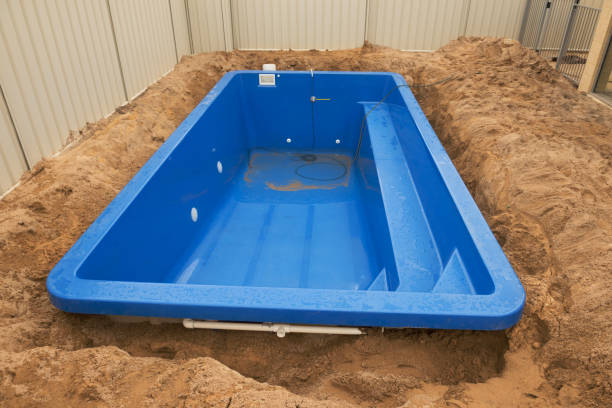
Factors Affecting Slipperiness of Fiberglass Pools
When it comes to fiberglass pools, many people wonder if they are slippery. The answer is that it depends on a variety of factors. In this section, we will explore the different factors that can affect the slipperiness of fiberglass pools.
Pool Surface Texture
The texture of the pool surface is one of the main factors that can affect slipperiness. Fiberglass pools come in a variety of textures, from smooth to textured. Smooth surfaces can be more slippery, especially when wet, while textured surfaces can provide more grip. Some fiberglass pools have a gel coat surface that can be textured to provide more traction.
Water Conditions
Water conditions can also affect the slipperiness of fiberglass pools. The presence of algae or other contaminants in the water can make the surface of the pool more slippery. Proper pool maintenance, including regular cleaning and chemical treatment, can help to prevent the buildup of contaminants and reduce slipperiness.
User Behavior
Finally, user behavior can also play a role in the slipperiness of fiberglass pools. Running, jumping, and diving can all increase the risk of slipping and falling. It is important to practice safe behavior in and around the pool, including walking slowly and carefully on the pool deck and avoiding horseplay.
In conclusion, the slipperiness of fiberglass pools can be affected by a variety of factors, including the texture of the pool surface, water conditions, and user behavior. By taking steps to address these factors, pool owners can help to reduce the risk of slips and falls and ensure a safe and enjoyable swimming experience.
Comparing Slipperiness: Fiberglass vs Other Pool Materials
When it comes to pool safety, slipperiness is a major concern. Fiberglass pools are often marketed as being less slippery than other pool materials, but is this really the case? Let’s compare the slipperiness of fiberglass pools to other common pool materials.
Concrete Pools
Concrete pools are one of the most popular pool materials, but they can be quite slippery. The smooth surface of the concrete can become even more slippery when wet, making it a potential safety hazard. To combat this, some concrete pool owners add a textured finish to the surface to increase traction.
Vinyl Liner Pools
Vinyl liner pools have a smooth surface similar to fiberglass pools, but they can be more slippery when wet. The vinyl liner material itself can be quite slick, and this can be exacerbated by algae growth or other debris on the surface.
Natural Stone Pools
Natural stone pools, such as those made from granite or limestone, can be quite rough and textured, which can make them less slippery than other pool materials. However, the natural variations in the stone can also create uneven surfaces that can be tripping hazards.
Fiberglass Pools
Fiberglass pools are often marketed as being less slippery than other pool materials, and there is some truth to this claim.
The gel coat surface of fiberglass pools is typically quite smooth, but it also has a slight texture that can provide some traction. Additionally, the surface of fiberglass pools is non-porous, which means that algae and other debris are less likely to accumulate and create a slippery surface.
Overall, while fiberglass pools may not be completely slip-proof, they do offer some advantages over other pool materials when it comes to slipperiness. However, it’s important to remember that proper pool maintenance and safety precautions are always necessary to ensure a safe swimming experience.

Preventing Slipperiness in Fiberglass Pools
Fiberglass pools are a popular choice for homeowners due to their durability, low maintenance, and affordability. However, one concern that some people have is whether fiberglass pools are slippery. While fiberglass pools can be slippery, there are several ways to prevent slipperiness and ensure a safe swimming experience.
Anti-Slip Coatings
One solution to prevent slipperiness in fiberglass pools is to apply an anti-slip coating. Anti-slip coatings are designed to increase traction and reduce the risk of slipping. These coatings can be applied to the entire pool or just the areas that are most prone to slipping, such as steps and ledges.
There are several types of anti-slip coatings available, including epoxy, rubber, and acrylic. Epoxy coatings are durable and long-lasting but can be expensive.
Rubber coatings are affordable and easy to apply but may need to be reapplied periodically. Acrylic coatings are a popular choice due to their affordability, ease of application, and durability.
Safety Measures
Another way to prevent slipperiness in fiberglass pools is to implement safety measures. Here are some safety measures to consider:
- Install handrails: Handrails provide swimmers with something to hold onto while entering and exiting the pool, reducing the risk of slipping.
- Use non-slip mats: Non-slip mats can be placed in areas that are prone to slipping, such as steps and ledges.
- Keep the pool deck clean: A clean pool deck is less likely to be slippery. Regularly sweep and power wash the deck to remove any debris or algae.
- Use proper footwear: Encourage swimmers to wear proper footwear, such as water shoes, to increase traction and reduce the risk of slipping.
By implementing these safety measures and considering anti-slip coatings, homeowners can prevent slipperiness in their fiberglass pools and ensure a safe swimming experience for themselves and their guests.

Conclusion
In conclusion, fiberglass pools can be slippery, just like any other type of pool surface. However, there are ways to minimize the risk of slipping and falling.
One effective way is to use non-slip additives in the pool surface. These can be added during the manufacturing process or applied later on. Another option is to use pool mats or non-slip coatings on the pool deck.
It is important to note that proper maintenance and cleaning of the pool surface and deck can also help prevent slips and falls. Regularly removing debris and algae buildup can improve traction and reduce the risk of accidents.
Overall, while fiberglass pools may have a reputation for being slippery, taking preventative measures can greatly reduce the risk of accidents and injuries.

